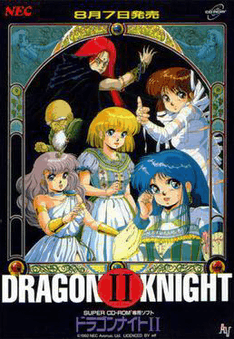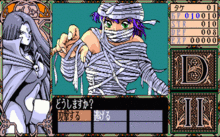Dragon Knight II
| Dragon Knight II | |
|---|---|
 PC Engine cover art | |
| Developer(s) | ELF Corporation TamTam (PC Engine) |
| Publisher(s) | ELF Corporation NEC Avenue (PC Engine) |
| Director(s) | Fumiko Suzuki |
| Producer(s) | Sachio Ishihara Toshio Tabeta |
| Designer(s) | Masato Hiruta Takami Sugimoto |
| Programmer(s) | Atsushi Kanao Takefumi Kawakami Hideki Iwatsuki |
| Artist(s) | Hiromitsu Suga Atsuki Mizusawa Kouichi Mikado |
| Composer(s) | Torou Hara Tomoyuki Hamada Shinji Yoshikawa |
| Series | Dragon Knight |
| Platform(s) | MSX2, NEC PC-8801, NEC PC-9801, Sharp X68000, PC Engine Super CD-ROM² |
| Release date(s) | PC-98 December 20, 1990 X68000 February 28, 1991[1] MSX2 March 1991[2] PC Engine August 7, 1992[2] |
| Distribution | Floppy disk, CD-ROM |
Dragon Knight II (ドラゴンナイトII) is a fantasy-themed eroge role-playing video game in the Dragon Knight franchise that was originally developed and published by ELF Corporation in 1990-1991 only in Japan as the first sequel to the original Dragon Knight from 1989. The game is an erotic dungeon crawler in which a young warrior Takeru fights to lift a witch's curse that turned girls into monsters. After the success of Dragon Knight II , ELF followed up with Dragon Knight III / Knights of Xentar in 1991. A censored remake of Dragon Knight II was published by NEC Avenue in 1992.
Gameplay

Dragon Knight II is available only in Japanese. Its gameplay system has not changed much since the first Dragon Knight game, as it is still a standard dungeon crawler with first-person view perspective and 2D graphics. The player spends most of the time navigating mazes and fighting enemies. As progress is made, the mazes will become more complicated, but as in the first game there is an aid for the player in the form of a of minimap with grid coordinates. The player can also visit shops and converse with non-hostile NPCs. The game starts with just one player character, Takeru, but two other characters join up later on. The game's battle system has also undergone minor changes. It still features turn-based battles that are mostly randomly generated, but the fights are better balanced than in the first game. The player can attack, defend, and use spells and items to deal with various types of female enemies (such as berserker, banshee, catgirl, centaur, elf, harpy, ninja, mummy, werewolf, and so on), who are being fought only one at a time. These enemies are actually girls who have been transformed into monsters, and whenever player character fights off one of them, the subdued enemy loses her clothing. Later, when the enemies revert to their normal self, in their grattitude they offer themselves to have sex with the protagonist in a cutscene. There is also only one boss to beat.[3][4]
Plot
The vagabond young of the first Dragon Knight, Takeru Yamato, wanders into a small town of Phoenix and finds it terrorized by the wicked woman known as Mesaanya. Phoenix had been once ruled by a race of she-devils known as Witches until they were attacked by their male Dragon Knight rivals and almost wiped out in a fierce battle that almost destroyed the town three centuries ago. Soon after Takeru's arrival, a girl named Kate is about to enagage with her fiancé Pierrot, but Mesaanya steals the set of seven demon-sealing holy scriptures that Takeru delivered, possesses Kate, and also kidnaps twenty-eight other village girls and turns them into minions to guard the Witch Tower. Takeru decides to enter the tower and collect the scriptures to hopefully break the curse and ultimately rid of Mesaanya.
uring the course of the game, Takeru is joined by a burly merchant named Burn, who has originally sent him to Phoenix, and a mysterious spell-casting priestess named Sophia. Eventually, the bewitched girls are saved, as is Kate's fiancé Pierrot who went first to rescue her but was badly injured. However, Mesaanya's throne room in her lair at the top of the tower is found empty and Kate herself is also not found. Looking for them, Takeru learns how Dragon Knights defeated Witches by using the Falcon Sword made from a special metal and the Genji Armor capable of resisting magic. Searching of these artifacts, the party descends into a hidden dungeon where Burn reveals he is a grandson of the Dragon Knight survivor, who reformed after the devastating battle 300 years ago and became a mortal human. In a twist ending, it turns out that Sophia's true identity has been really a disguised Mesaanya in a ploy to secure the hidden sword and armor, as well as to identify and eliminate the descendant of Dragon Knight. Her magic blast gravely wounds Burn, but she is shocked when the legendary armor wraps itself on Takeru, and the final fight ensues. When Mesaanya is slain, Kate is freed from her spell and Burn is found to be still breathing. With his quest completed, Takeru then spends a night with Kate before leaving for his further adventures.[5]
Characters
- Takeru Yamato (ヤマト・タケル) - a womanizing young swordsman who arrives in Phoenix following his victory over the evil Dragon Knights after Burn made him deliver the scriptures there. He is the protagonist of most media in the Dragon Knight franchise. Voiced by Akira Kamiya.
- Burn (Baan) (バーン) - a traveling merchant of great physical strength, who first sends Takeru to Phoenix and later joins him on his quest. He seems to be harboring a secret for why he has been avoiding Phoenix. Voiced by Banjo Ginga.
- Sophia (Sofia) (ソフィア) - a beautiful white magic-user who arrives to aid Takeru mid-game claiming she heard about the situation. She is capable of casting healing and teleportation spells. Voiced by Sumi Shimamoto.
- Mesaanya (Mesanya) (メサーニャ) - a daughter of the queen of Witches from 300 years ago, who hates men and wants to restore her kind to power. When Mesanya has first arrived in Phoenix three years before the events of the game she appeared very friendly and gained the villagers' trust, but recently she revealed her true colors as she took over the Witch Tower and forbade the love between men and women. Voiced by Yumi Nakatani.
- Elder (チョウロウ) - the old chief of Phoenix, who has been looking for a way to defeat Mesaanya and restore peace to the village. Voiced by KYada.
- Kate (ケイト) - granddaughter of the village's Elder who is taken hostage by the witch, who also uses her a her sexual plaything and to taunt the heroes. Voiced by Aya Hisakawa.
Other charactres include: Weaponsmith (Yukitoshi Hori), Apothecary (Isamu Tanonaka), Taverner (Totani Koji), Witch (Hiroyuki Sato), Rem (Lisa Hatayama), Mei (Noriko Namiki), Messiah (Natsuko Yamada), Merumo (Mayumi Horikawa), Cherry (Akiko Sato), Orchid (Azusa Nakao), Mami (Kaori Ohara), Hamy (Minako Takenouchi), Rika (Tomomi Uesaka), Monami (Masami Suzuki), Mischa (Mihoko Fujiwara), Tanya (Yasuko Kajimura), Nadia (Yuki Kato), Bunny (Junko Shimakata), Mimi (Yoko Asada), Paula (Naomi Matamura), Betty (Yumiko Sakita), Marie (Mayumi Seto), Lina (Mayumi Shigeno), Eve (Megumi Kanba), Nina (Naoko Nakamura), Lara (Yasuko Hirayama), and others. The game was narrated by Kaneto Shiozawa.[6]
Release
The game was originally released in 1990-1991 for the MSX2, NEC PC-8801, NEC PC-9801 and X68000 computer systems. An enhanced PC Engine port that removed sexually explicit content but added voice acting and new graphics was developed by TamTam and released by NEC Avenue in 1992 among controversies[7] as the first erotic game officially published for a video game console. Two soundtracks were released in Japan by NEC Avenue: Dragon Knight II Fantastic Remix! (ドラゴンナイト II ファンタスティック・リミックス!) in October 1991[8][9] and Dragon Knight II PC Engine World (ドラゴンナイト II ~PCエンジンワールド) in 1992, distributed by Nippon Columbia.[10][11]
Reception
Just like its predecessor, Dragon Knight II was a commercial success. The game placed third on MSX Magazine "MSX Soft Top 30" best-selling chart in May 1991,[12] and even one year later has remained there at 28th place.[13] Electronic Gaming Monthly (EGM) reported that Dragon Knight II "became a sleeper hit with Japanese role-playing fans. What made it popular is the fact that it was noticeably different from other RPGs because the game opted for lots of women instead of beasts, with some slight characteristics of monsters," predicting that "with more action and more scantily clad women to attack," its sequel "should really entice the Japanese market!"[14] EGM also included the game's "tons of interesting people to meet" in their 1993 ranking of "Top Ten Hottest Video Game Babes" at second place.[15]
Sequel
Takeru (renamed Desmond in the West) returns as the hero of the 1991 sequel Dragon Knight III, which is titled Knights of Xentar in its Western version. Phoenix, where the former Witch Tower which has been renamed as the Tower of Takeru (Desmond), is revisited in the game. The recovered Burn / Baan (renamed Rolf in the West) rejoins Takeru to fight demons and the now-married Kate is also met (and laid) again.
References
- ↑ "Dragon Knight II Release Information for Sharp X68000". GameFAQs.com. 1991-02-28. Retrieved 2015-03-29.
- ↑ 2.0 2.1 "Dragon Knight II Release Information for MSX". GameFAQs.com. Retrieved 2015-03-29.
- ↑ "Dragon Knight 2 . Прохождение Dragon Knight 2. Секреты Dragon Knight 2. — Square Faction". Squarefaction.ru. 2015-02-24. Retrieved 2015-03-29.
- ↑ "PCエンジンCD-ROM2「ドラゴンナイトII」の感想・レビュー・批評|ゲーム好きTVgamerさんのブログ。". Ameblo.jp. 2012-03-17. Retrieved 2015-03-29.
- ↑ "retro game report 'DRAGON KNIGHT II']". F-long.com. Retrieved 2015-03-29.
- ↑ "ドラゴンナイトII (美少女ゲーム移植リスト)". Galgame.himegimi.jp. 1990-11-30. Retrieved 2015-03-29.
- ↑ "エルフソフト陥落の歴史". Repadars.org. Retrieved 2015-03-29.
- ↑ MSX Magazine 10/91, page 61. (Japanese)
- ↑ MSX Magazine 11/91, page 62. (Japanese)
- ↑ "NACL-1043 | Dragon Knight II Fantastic Remix!". VGMdb. Retrieved 2013-12-17.
- ↑ "NACL-1078 | Dragon Knight II PC Engine World". VGMdb. Retrieved 2013-12-17.
- ↑ MSX Magazine 5/91, page 6. (Japanese)
- ↑ MSX Magazine 5/92, page 7. (Japanese)
- ↑ Electronic Gaming Monthly 43 (February 1993), page 64.
- ↑ Electronic Gaming Monthly 43 (February 1993), page 40.
External links
- Official website (Japanese)
- Dragon Knight II at MobyGames
- Dragon Knight II at Hardcore Gaming 101
- Dragon Knight II at The Visual Novel Database
- Strategy guide at The Brothers Duomazov
- MSX Magazine guide: part 1, part 2 (Japanese)
| ||||||||||||||